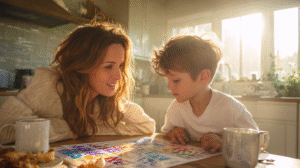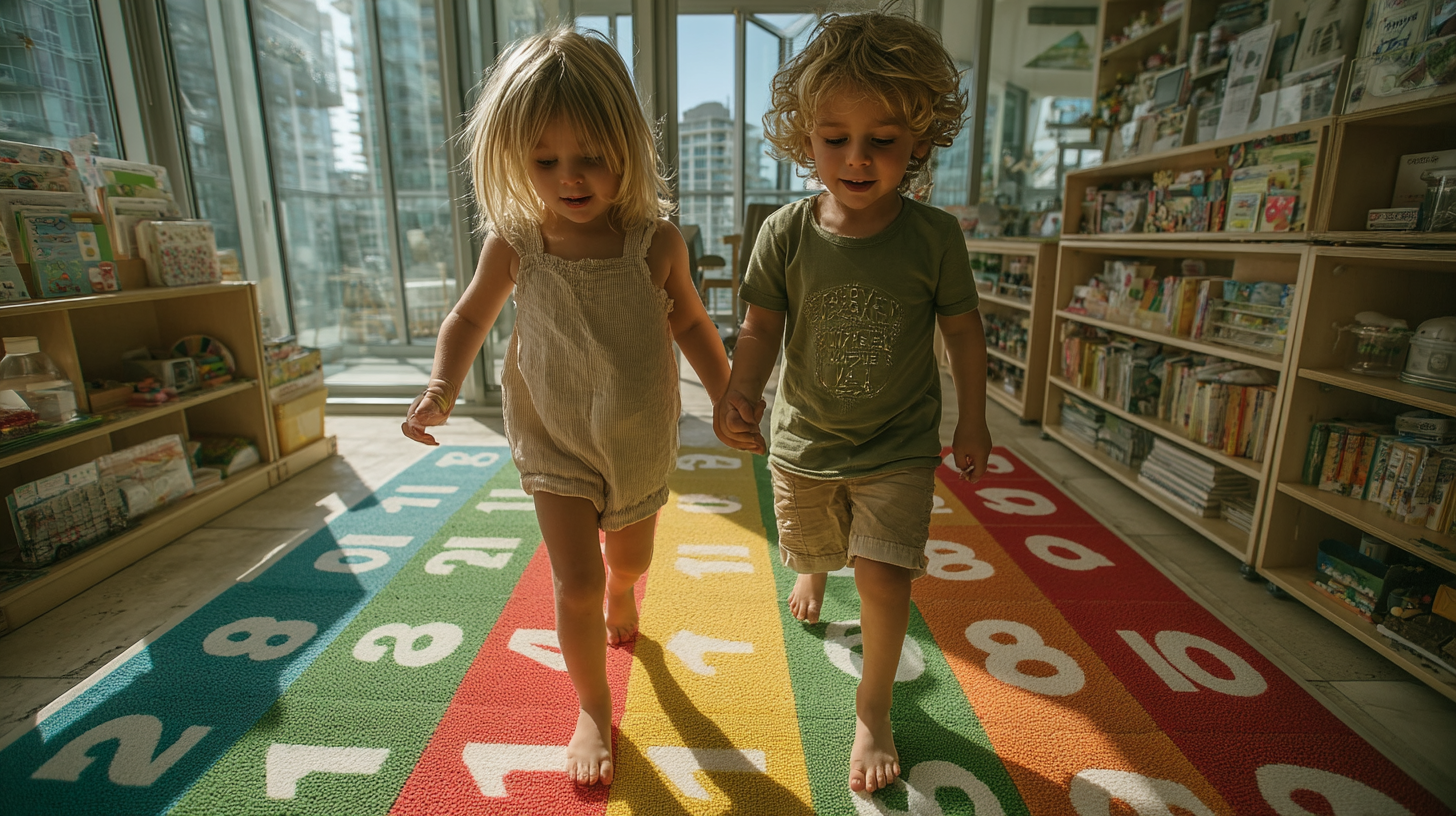
Morning Calendar Math: A Daily Routine to Build Number Sense
Morning Calendar Math: A Daily Routine to Build Number Sense As a former elementary math teacher turned homeschooling mom, I

Movement math activities aren’t just clever tricks—they’re lifesavers for parents like me.
“Mom, I’m bored!” my 4-year-old announced for the third time in ten minutes, bouncing on the couch like a human pogo stick. Meanwhile, my first-grader was sprawled on the floor, claiming he was “too tired” to practice his addition facts but somehow had enough energy to do somersaults across the living room.
Sound familiar? As a former middle and high school math teacher, I used to think the solution was getting kids to sit still and focus. But after years of watching my own children learn, I’ve discovered something revolutionary: movement isn’t the enemy of math learning – it’s the secret weapon.
The breakthrough came last spring when I watched my son count his way across the monkey bars at the playground. One, two, three… all the way to twenty. He wasn’t doing it because I asked him to; he was doing it because it made the challenge more engaging. That’s when I realized we’d been approaching math education all wrong.

The easiest way to start movement math activities is with basic counting games that feel like play rather than work. I’ve turned our hallway into a number line where my kids can physically jump from one number to the next, making addition and subtraction tangible and fun.
“Can you hop to number 5, then take 3 more hops?” I ask, and suddenly abstract math concepts become concrete experiences. My 4-year-old doesn’t realize she’s learning number sequences—she just knows she’s having fun jumping around the house.
We also play “counting tag” in the backyard, where the person who’s “it” has to count by twos, fives, or tens while chasing. This builds skip-counting skills while burning energy, and both kids beg to play it again and again.
The key is making the movement feel purposeful rather than random. When children have a mathematical goal tied to their physical activity, they naturally engage more deeply with both the movement and the math.
Cooking becomes one of the most delicious movement math activities when we let kids move around and participate actively. Measuring ingredients isn’t just about fractions—it’s about spatial reasoning, estimation, and fine motor skills all wrapped together.
I hand my kids measuring cups and let them walk back and forth between the pantry and counter, counting scoops and discussing concepts like “half” and “double.” They’re learning measurement while getting their steps in, and the kitchen becomes our most productive classroom.
We also practice counting and grouping by having them sort ingredients into bowls. “Can you count out 24 chocolate chips and put them in groups of 6?” This combines counting, division, and pattern recognition while keeping little hands busy.
The best part? These movement math activities end in a tasty reward.
Nature provides endless opportunities for movement math activities when we know how to look for them. During our daily walks, we count trees, estimate distances, and compare sizes—all while getting fresh air and exercise.
“How many steps do you think it will take to reach that red mailbox?” I ask, encouraging prediction and estimation skills. Then we count our steps to test our hypothesis, introducing basic concepts about data collection and accuracy.
We also practice patterns using natural objects. Collecting rocks, leaves, or flowers and arranging them in sequences helps children understand mathematical relationships through hands-on exploration.
These activities work because they connect movement math activities to the real world—not just workbook pages.
Chores might seem like the enemy of fun, but they’re secretly one of the best platforms for movement math activities. “Let’s see if we can put away all 15 blocks before I count to 30,” I’ll say, turning tidying into a race that involves both math and motion.
Laundry sorting becomes a lesson in classification and counting. “Can you find all the red socks and count them?” This teaches color recognition, counting, and categorizing.
We also practice basic operations through chore distribution. “There are 12 toys on the floor. If you pick up 7 and your sister picks up the rest, how many does she get?” Kids begin to see that math helps solve everyday problems.
Among our favorite weekend movement math activities are family workouts that combine goal-setting, counting, and teamwork.
“Let’s see if we can do 50 jumping jacks together. I’ll do 20, Dad will do 15, and you two split the rest.” That’s addition, subtraction, and division—all embedded in physical effort.
We also track workout times and compare them. “Yesterday we finished in 12 minutes. Today it took 15. How much longer was it today?” This turns elapsed time into a teachable moment.
These challenges prove that movement math activities can foster both healthy habits and number fluency in a fun, collaborative way.
The best part about movement math activities is that kids often don’t realize they’re learning—they just think they’re playing.
By connecting movement with math, we help children develop positive relationships with numbers that last far beyond early childhood.
When kids feel empowered by their bodies and their brains working together, math transforms from something intimidating into something joyful.
This approach supports different learning styles, honors natural energy, and gives parents a new tool for helping kids build confidence.
Because sometimes the most powerful math lesson happens while jumping, running, sorting, or skipping—all thanks to a little movement.

Morning Calendar Math: A Daily Routine to Build Number Sense As a former elementary math teacher turned homeschooling mom, I

Brushing Teeth Countdown: 5 Powerful Fun Tips for Kids As a former math teacher turned mom of two, I thought

Cooking Fractions for Kids: 7 Fun & Tasty Ways to Learn Math Last Tuesday, my 8-year-old son Jake stared at
*Also read:
25 Brilliant LEGO Math Activities to Build Number Sense and STEM Skills at Home
Teach Kids to Tell Time: The Clock Game Every Parent Should Try at Home